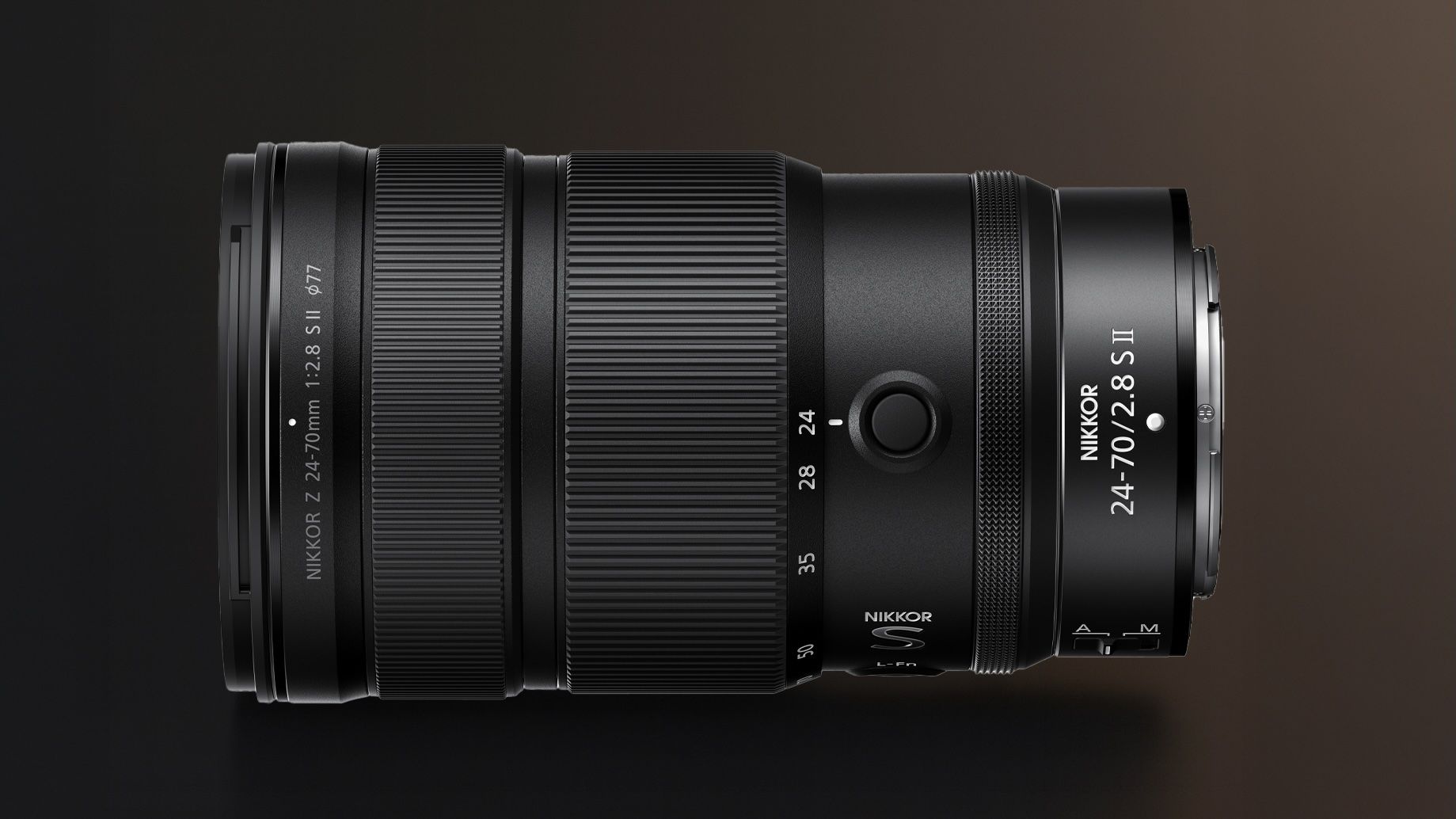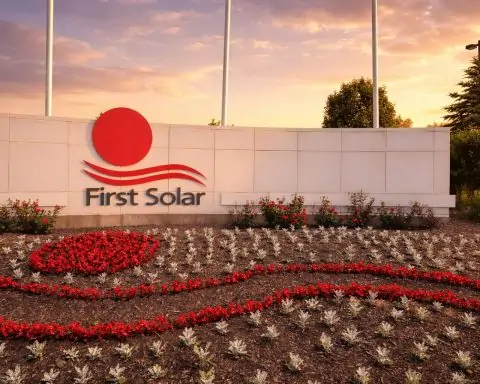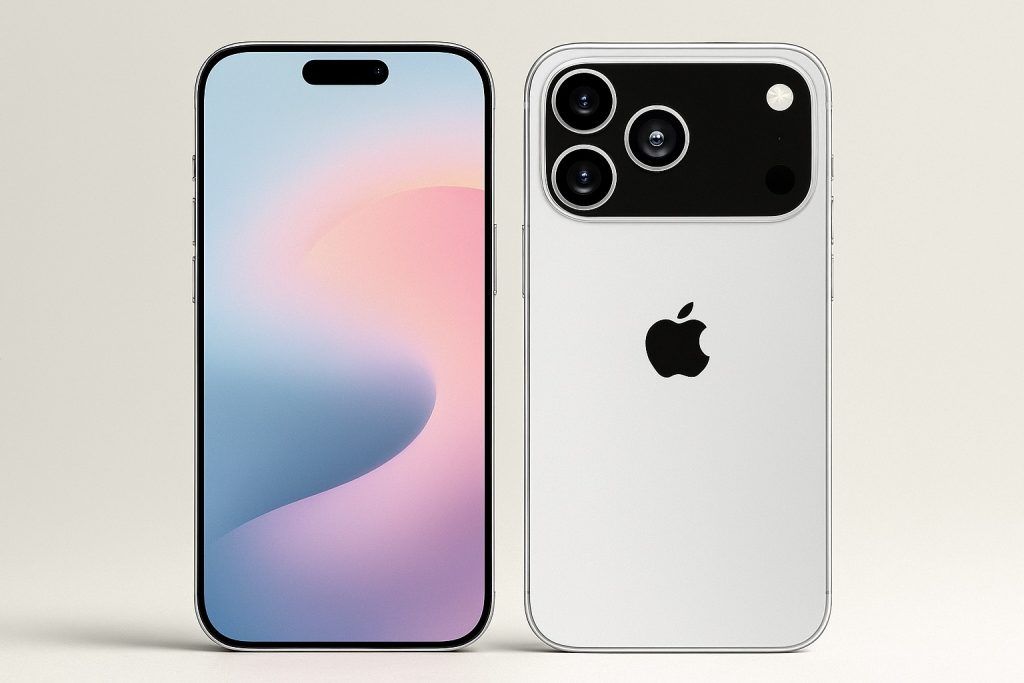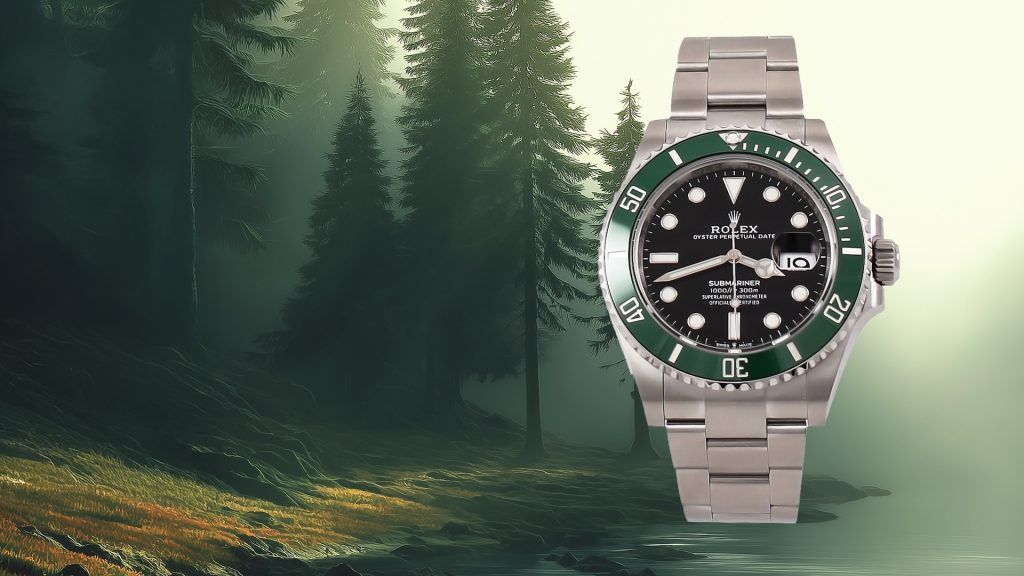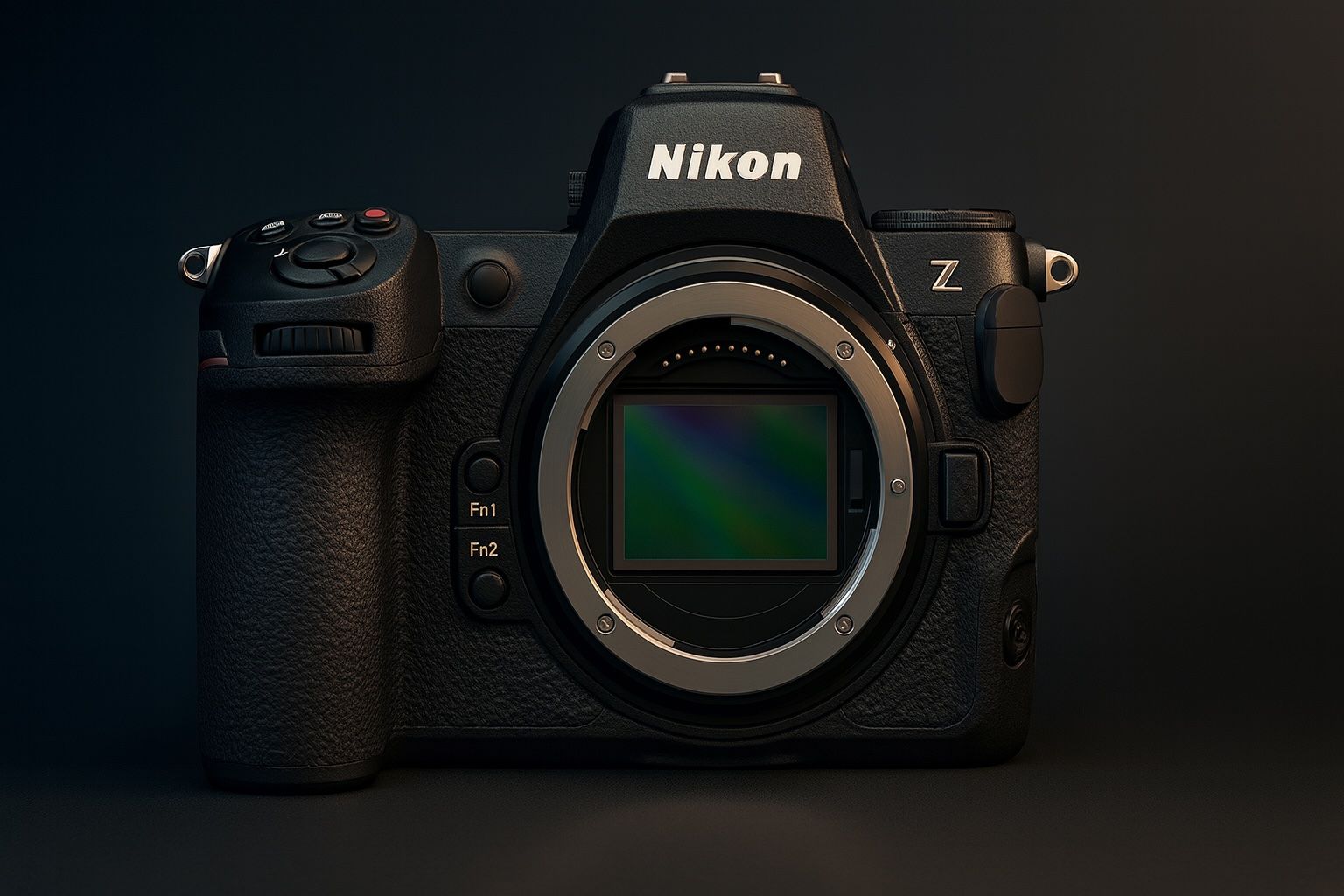- The Nikon NIKKOR Z 24-70mm f/2.8 S II was announced on August 22, 2025 as a second-generation update to Nikon’s flagship Z-mount standard zoom.
- The S II uses Nikon’s Silky Swift VCM (SSVCM) focusing motor, delivering about five times faster autofocus than the previous Z 24-70mm f/2.8 S.
- It is the first 24-70mm f/2.8 mirrorless lens to feature internal zoom, keeping a constant length of 142 mm (versus 126 mm at 24 mm on the original).
- The lens weighs 675 g, about 130 g lighter than the first-generation 805 g model and lighter than Sony’s 695 g GM II and Canon’s 900 g RF 24-70mm.
- Optically, it uses 14 elements in 10 groups, including 2 ED glass and 3 aspherical elements, plus a large double-sided aspherical front element and coatings such as Meso Amorphous Coat, ARNEO, and Nano Crystal.
- Minimum focus distance is 0.24 m at 24 mm and 0.33 m at 70 mm, yielding a maximum magnification of 0.32× at 70 mm.
- Nikon notes reduced focus breathing and near-silent focus motors, with about 60% better AF tracking during zoom than the previous model.
- Handling enhancements include a programmable L-Fn button, a new focus limiter switch (FULL/∞–0.5 m), a control ring with a click switch, and a sliding filter window in the lens hood.
- The top OLED display is omitted on the S II to save weight, though a distance scale remains on the lens for quick reference.
- Price is $2,799.95 USD, higher than Canon’s approximately $2,299 and Sony’s roughly $2,299–$2,448 GM II, with Nikon noting no native third-party 24-70 f/2.8 options in Z-mount.
Introduction: Nikon has unveiled the NIKKOR Z 24-70mm f/2.8 S II, a second-generation update to its flagship standard zoom for Z-mount full-frame mirrorless cameras (announced August 22, 2025) [1] [2]. This new lens is a workhorse aimed at professional photographers and hybrid shooters, delivering improvements in autofocus speed, optical design, and handling. Notably, Nikon claims it is the fastest-focusing and lightest lens in its class – outperforming rival 24–70mm f/2.8 zooms from Canon and Sony in weight and focusing speed [3] [4]. In this report, we’ll explore the technical specifications, new features, build quality, and use cases of the NIKKOR Z 24-70mm f/2.8 S II. We’ll also include expert commentary and then compare Nikon’s latest offering directly with its major competitors: Canon’s RF 24-70mm f/2.8L IS USM and Sony’s FE 24-70mm f/2.8 GM II. We’ll highlight each lens’s strengths, weaknesses, pricing, performance, and design trade-offs, with source links to credible reviews and official data.
Nikon NIKKOR Z 24-70mm f/2.8 S II – Key Features and Improvements
The NIKKOR Z 24-70mm f/2.8 S II is a premium constant f/2.8 aperture zoom covering 24–70mm, a staple range for everything from wide-angle landscapes to portraiture. Nikon’s original Z 24-70mm f/2.8 S (released 2019) was already highly regarded – DxOMark dubbed it “the new benchmark” among 24-70mm lenses [5] [6]. The new S II version builds on that foundation with several significant upgrades:
- Fastest Autofocus in Nikon’s History: The S II debuts Nikon’s Silky Swift VCM (SSVCM) focusing motor in a zoom lens, enabling extremely fast and precise AF. Nikon claims the autofocus is approximately 5× faster than the previous Z 24-70mm f/2.8 S [7]. In fact, with cameras using the latest Expeed 7 processor, the S II achieves the fastest AF of any Nikon lens ever [8]. This translates to quicker focus acquisition and improved tracking of moving subjects. PetaPixel notes Nikon’s “remarkable claim” here and looks forward to independent testing [9]. In practical terms, action shooters will benefit – even though 24–70mm isn’t a typical sports lens, the boosted speed and a new focus tracking algorithm during zoom (improved by ~60% vs the old model) make it easier to keep up with fast-moving subjects [10] [11].
- Internal Zoom Mechanism: The S II is the first 24-70mm f/2.8 mirrorless lens to feature internal zoom – its length remains constant throughout the zoom range [12] [13]. Unlike most 24-70 lenses (which extend when zooming to 70mm), the Nikon S II’s barrel does not elongate. This design provides better balance and stability, especially for video. The lens won’t shift its center of gravity on a gimbal or rig, and it minimizes “air pumping” that can draw dust into the lens [14]. Nikon specifically notes the internal zoom “maintains its balance” and improves dust- and drip-resistance [15]. This is a boon for videographers using follow-focus or gimbal setups, as framing remains consistent and there’s no need to rebalance when changing focal length [16]. Trade-off: internal zoom makes the lens a bit longer in its static form (142 mm long) compared to the original (which was 126 mm at 24mm) [17]. Nonetheless, it’s a well-sealed design for shooting in harsh environments.
- Significantly Lighter Weight: Despite the internal zoom and pro build, the S II is the lightest lens in its class, weighing approx. 675 g (1.49 lb) [18] [19]. This is 130 g lighter than the first-gen Z 24-70 (805 g) [20]. It even undercuts the famously light Sony 24-70mm GM II (695 g) and is far lighter than Canon’s RF 24-70mm (900 g) [21]. Nikon achieved this weight reduction through a revised optical formula (reducing the number of elements from 17 down to 14) and a smaller 77 mm front element (the previous used 82 mm filters) [22] [23]. Handholding the lens is less fatiguing, and the compact 84 mm diameter with 77 mm filter threads may also save cost/weight on filters [24] [25]. (On the flip side, some photographers who have standardized on 82 mm filters might need step-up rings or new filters – one user noted the switch back to 77 mm as a minor inconvenience [26].)
- Outstanding Optics and Coatings: Nikon promises “the highest level of image quality in the S-Line” from this lens [27]. The optical construction is 14 elements in 10 groups, including 2 ED glass and 3 aspherical elements, one of which is a large double-sided aspherical front element [28] [29]. This advanced design allowed reducing the element count while maintaining excellent correction of aberrations. The lens debuts Nikon’s new Meso Amorphous Coat (in addition to ARNEO and Nano Crystal coatings) for superior anti-reflection – Nikon says it’s their best-ever coating tech to combat flare and ghosting [30]. Early indications are that sharpness and contrast are exemplary across the frame, even wide open. (The previous Z 24-70 was already “extremely sharp,” tying or beating peers in most metrics [31] [32], so we expect the S II to perform at least as well or better.) The aperture diaphragm is also upgraded from 9 blades to 11 rounded blades, which should yield even rounder bokeh balls and smoother out-of-focus areas [33].
- Closer Focus for Semi-Macro Shots: The minimum focus distance has been improved. The S II can focus as close as 0.24 m at 24mm, and 0.33 m at 70mm [34]. This yields a maximum magnification of 0.32× (about 1:3.1 life-size) at 70mm [35]. In comparison, the first-gen lens could only do ~0.22×. This is a significant improvement – photographers can get closer to subjects for detail shots, food, small products, etc., without needing a dedicated macro lens. Nikon highlights the “dynamic expression” possible by getting as close as ~0.8–1.1 ft from your subject [36]. While not a true macro, 0.32× is among the best in class for a 24-70 f/2.8 zoom, edging out Canon’s 0.30× and matching Sony’s 0.32× max magnification [37] [38].
- Video Optimization – Reduced Focus Breathing: Recognizing the growing demand from hybrid creators, Nikon designed the S II for cinematic focusing performance. The lens suppresses focus breathing (the slight change in angle of view when pulling focus) [39]. This means when you rack focus during video, the framing won’t noticeably zoom in or out. It’s a critical feature for professional video work and one that Canon’s older design does not emphasize as strongly. Additionally, the SSVCM focus motors operate extremely quietly with minimal vibration [40], so autofocus noise won’t spoil audio recording. Combined with the internal zoom (preventing balance shifts) and Nikon’s in-body stabilization, the S II is tailor-made for videography on Z-mount bodies. Nikon also notes improved AF tracking when zooming (60% better than before) which helps maintain focus on a subject if you zoom during a take [41].
- Enhanced Handling and Controls: Nikon retained and improved the pro-oriented controls on the lens barrel. Like its predecessor, the S II has a tactile L-Fn programmable button and a switch for A/M focus mode. New on this model, Nikon added a focus limiter switch (“FULL/∞–0.5m” range) – a rare feature on a 24-70, allowing you to restrict AF to avoid the closest distances and speed up subject acquisition (useful for action shooting). Another welcome addition is a control ring click switch: the lens’s programmable control ring (which can adjust aperture, ISO, focus, etc.) can be set to either clicked steps or smooth rotation [42]. Videographers can de-click for noise-free smooth aperture changes, while photographers who prefer tactile feedback can enable clicks – all with a simple switch. This was not possible on the old model (which was smooth-only without detents) [43]. The lens hood also features a clever sliding filter window [44]. If you use a circular polarizer or variable ND filter, you can rotate it through this little door in the hood without removing the hood – a very handy touch for landscape shooters and filmmakers [45]. Overall, these refinements make the S II more user-friendly and versatile for different shooting scenarios.
- Omitted OLED Display (Design Trade-off): One change that may polarize some existing Nikon users is the removal of the top-mounted OLED info display. The original 24-70mm S had a small screen to show focus distance, focal length, or aperture. The new S II does not include this OLED panel [46]. This was likely done to save weight and simplify the design (and perhaps because many users didn’t find the display essential). Some photographers may miss the quick glance info, but others find it inconsequential [47]. Importantly, the critical information can still be seen in-camera, and the lens retains a distance scale engraving. Given the 130 g weight savings and added physical controls, most will consider this omission a reasonable trade-off.
Expert Commentary: Many professionals consider a 24–70mm f/2.8 an indispensable “daily driver” lens. Photographer Christopher Malcolm writes that this zoom range “fits just about 99.9% of what I like to shoot,” calling his 24-70 f/2.8 the lens he leaves on his camera “full-time” [48]. With the Z 24-70mm f/2.8 S II, Nikon is clearly targeting those pros and demanding enthusiasts who rely on a 24-70 as their go-to lens for weddings, events, reportage, travel and video work. Early impressions of the S II highlight Nikon’s aggressive improvements. As Fstoppers quipped, Nikon “has grown tired of [our] complacency and has sought to shake things up” by delivering major upgrades in autofocus, weight and features on an already excellent lens [49]. PetaPixel likewise notes that Nikon is staking a claim for the new S II as “the lightest 24-70mm f/2.8 full-frame lens on the market, besting even the featherweight Sony…,” while bringing innovations like internal zooming for added stability [50] [51]. The proof will be in hands-on testing, but expectations are high that this lens will continue Nikon’s record of optical excellence. As DxOMark’s labs said about the first version: “If you want the best all-around image quality from a 24-70mm lens, the Nikon Nikkor Z 24-70mm f/2.8 S is the lens to go for.” [52] The Mark II appears poised to uphold that reputation, with even faster performance and improved handling for both stills and video.
Build Quality and Intended Use Cases
The NIKKOR Z 24-70mm f/2.8 S II is built to Nikon’s professional S-Line standards, meaning a high-grade metal/composite construction with extensive weather-sealing. All moving parts and joints are sealed against dust and moisture, and the internal zoom design further prevents dust ingress during use [53]. Nikon rates it as dust- and drip-resistant (though not absolutely waterproof) for reliable outdoor use [54]. A fluorine coating on the front element helps repel water, oil and smudges [55]. This robust build aligns with the lens’s role as a daily workhorse for pros who might shoot in rain, sand, or dusty venues. Despite the solid build, the lighter weight (675 g) makes it easier to carry on long assignments or hikes [56], and it balances well on Nikon’s full-frame Z bodies (Z8, Z9, Z6/7 series, etc.).
Photographic Use Cases: As a 24-70mm f/2.8, this lens is a jack-of-all-trades in a pro’s kit. At 24mm it covers wide-angle views for landscapes, environmental portraits, architectural scenes or group shots. At 70mm it’s great for tighter portraits, isolating subjects with pleasing background blur thanks to f/2.8 and 11-blade bokeh. Event and wedding photographers will use the full range – capturing venue overviews at 24mm and candid close-ups at 70mm, all without changing lenses. Photojournalists and travel photographers favor 24-70mm for its versatility and low-light capability. The f/2.8 aperture is bright enough for indoor ceremonies, evening scenes or shallow depth-of-field effects. With the improved close-focus (0.32× magnification), the S II can handle detail shots (rings, food, textures) that previously might require a macro – making it even more useful for wedding shooters or backpack travelers who need to pack light. Sports shooters don’t typically use 24-70 as a primary lens, but for court-side or media scrums it can certainly capture action, and the S II’s snappy AF and focus limiter will help keep up with fast subjects. In short, any scenario from documentary street photography to studio work can be covered by this range, which is why so many pros deem a 24-70/2.8 their “standard, everyday workhorse” lens [57].
Videography Use Cases: Nikon clearly had video creators in mind with this lens. The internal zoom and reduced breathing have obvious benefits for filmmaking – one can zoom during a shot or pull focus without destabilizing the camera or noticeably changing composition [58] [59]. The near-silent AF motors and the ability to de-click the control ring mean you can rack focus or adjust aperture smoothly while recording, with no click noise or abrupt exposure jumps [60]. Paired with a Nikon Z camera’s in-body IS, the lack of optical VR is not a big issue; in fact, the lens’s lighter weight and constant length arguably make gimbal work easier than a heavier, extending lens. The S II should excel for gimbal-mounted shots, run-and-gun documentary filming, weddings, and any scenario where one needs to be a one-person crew capturing both wide and tight shots quickly. The fast f/2.8 aperture also helps in low-light video and achieving a cinematic shallow focus look. Additionally, Nikon’s claim of improved AF tracking during zoom will benefit anyone who likes to execute a dramatic zoom-in while keeping the subject sharp – something that could cause focus to drift on lesser lenses [61]. From YouTubers and wedding filmmakers to news videographers, a reliable 24-70 that performs silently and smoothly is highly sought after, and Nikon appears to be delivering exactly that.
Specs Comparison: Nikon Z 24-70mm f/2.8 S II vs Canon RF 24-70mm f/2.8L IS vs Sony FE 24-70mm f/2.8 GM II
How does Nikon’s new standard zoom stack up against the main competitors from Canon and Sony? Below is a side-by-side comparison of key specifications:
| Specification | Nikon NIKKOR Z 24-70mm f/2.8 S II | Canon RF 24-70mm f/2.8L IS USM | Sony FE 24-70mm f/2.8 GM II |
|---|---|---|---|
| Mount / Format | Nikon Z (Full-frame FX) | Canon RF (Full-frame) | Sony E (Full-frame FE) |
| Launch Date | Aug 2025 (Announced) [62] | Sept 2019 (EOS R system) | Apr 2022 [63] |
| Optical Design | 14 elements in 10 groups [64] (2 ED, 3 Aspherical, Meso/ARNEO coats) | 21 elements in 15 groups [65] [66] (3 UD, 3 Aspherical, Air Sphere coating) | 20 elements in 15 groups [67] [68] (2 ED + 2 Super ED, 5 Aspherical including 2 XA, Nano AR Coating II) |
| Aperture Blades | 11, rounded (new diaphragm) [69] | 9, rounded [70] | 11, rounded [71] [72] |
| Stabilization | No (relies on in-body VR) | Yes – 5-stop Optical IS [73] [74] | No (relies on in-body SteadyShot) |
| Autofocus Drive | Multi-focus with SSVCM linear motors (fastest Nikon AF) [75] | Nano USM (ultrasonic motor; smooth & silent) [76] | Four XD Linear Motors (floating focus design) [77] [78] |
| Min. Focus Distance | 0.24 m (at 24mm) / 0.33 m (70mm) [79] | 0.21 m (24mm) / 0.38 m (70mm) [80] | 0.21 m (24mm) / 0.30 m (70mm) [81] [82] |
| Max. Magnification | 0.32× (at 70mm) [83] | 0.30× (at 70mm) [84] | 0.32× (at 70mm) [85] [86] |
| Filter Thread | 77 mm [87] [88] | 82 mm [89] | 82 mm [90] |
| Dimensions (DxL) | Ø 84 mm × 142 mm (3.3″ × 5.6″) [91] [92] | Ø 88.5 mm × 125.7 mm (3.5″ × 4.95″) [93] | Ø 88 mm × 120 mm (3.46″ × 4.7″) collapsed [94] (extends to ~152 mm at 70mm) [95] |
| Weight | 675 g (1.49 lb) [96] [97] | 900 g (1.98 lb) [98] [99] | 695 g (1.53 lb) [100] [101] |
| Special Features | Internal zoom (constant length) [102]; Programmable L-Fn button; A/M switch; Focus limiter; Control ring with click on/off [103]; Digital display omitted (was on V1) | Extending zoom (physical length grows at tele); Lens Optical IS (up to 5 stops) [104]; Customizable control ring (clicking can be removed via service); No focus limiter; Weather-sealed L-series build | Extending zoom (extends ~32 mm) [105]; Aperture ring with de-click & lock; 2× customizable focus hold buttons; Zoom torque adjustment (Smooth/Tight); Fluorine coated; Weather-sealed (GM series) |
Sources: Nikon/Canon/Sony official specifications [106] [107] [108] and press materials [109] [110].
Performance and Design Discussion
In terms of optical performance, all three of these 24-70mm f/2.8 lenses are state-of-the-art for their systems. Nikon’s original Z 24-70mm was rated the best overall of its generation by DxO for its combination of sharpness, low aberrations, and balanced performance [111] [112]. The new Nikon S II is expected to match or exceed that level, especially with its new coatings and refined optics. Its MTF charts (not quoted here) indicate excellent edge-to-edge resolution. Canon’s RF 24-70mm f/2.8L IS is known as a very sharp lens as well, comparable to the earlier EF 24-70 II (which was one of the sharpest of the DSLR era) – optical reviews note the RF is “stunningly sharp” in the center with only minor edge softness wide open, and it benefits from in-camera corrections. Sony’s FE 24-70mm GM II has been lauded for achieving prime-like sharpness across the frame; Sony redesigned it to outperform the already excellent first-gen GM. In practical use, any differences in pure resolving power or bokeh quality between these three will be relatively subtle – all are capable of professional-quality images with beautiful background blur. Minor distinctions: the Canon may exhibit a touch more vignetting wide open (and has slightly more complex distortion at 24mm, corrected via profile), while the Sony GM II minimized the “onion ring” bokeh effect with its XA elements [113]. The Nikon’s 11-blade diaphragm will render slightly rounder bokeh highlights at mid apertures than Canon’s 9-blade, but Sony also has 11 blades so they are comparable there [114] [115].
Where the Nikon S II truly stands out is in handling and focusing performance. Its internal zoom mechanism is unique – neither the Canon nor the Sony offers this. Both competitors use a conventional extending barrel design (the Sony GM II extends ~32 mm when zoomed to 70mm [116], and the Canon extends similarly). This means the Nikon keeps its length fixed and balance steady on support gear, giving it an edge for video shooters and for keeping dust out [117] [118]. The trade-off is that the Nikon is longer when stored (142 mm vs only ~120 mm for the Sony when retracted) [119] [120]. In a camera bag, the Sony might fit in a slightly tighter space; the Canon sits in between (125.7 mm long at 24mm) [121]. Weight-wise, Nikon achieved the lightest build at 675 g, edging out Sony’s remarkably light 695 g lens [122]. Canon’s RF, at 900 g, feels noticeably heftier on camera – partly due to its older design and the inclusion of optical IS unit and larger glass elements [123]. Photographers who prioritize a lighter kit (say for travel or long events) will appreciate Nikon’s and Sony’s weight advantage. PetaPixel explicitly notes the Nikon S II “besting even the featherweight Sony…which weighs 695 g,” while Canon is “just under two pounds” [124].
Autofocus and speed: Nikon and Sony have both leveraged cutting-edge linear motor technology in these lenses. Nikon’s SSVCM system (with multiple focus groups) and Sony’s four XD linear motors aim to deliver blazingly fast and silent AF [125] [126]. Nikon is confident enough to claim the “fastest autofocusing in Nikon history” on the S II [127]. In real-world terms, the Sony GM II is already extremely fast at focusing – reviewers found it easily keeps up with 30 fps burst shooting on an Alpha 1 [128]. It’s likely the Nikon will perform similarly on an upcoming Z9 II or current Z8/Z9, given the 5× speed boost over the previous model [129]. Canon’s RF 24-70 uses a Nano USM motor – a very quiet and smooth focus drive that was a hybrid of ring USM and STM. It focuses quickly on Canon R bodies and also benefits from dual sensing IS and communication that helps with stability and AF accuracy [130] [131]. However, in absolute terms the Canon may feel a touch slower or less “snappy” than the newest tech in Nikon and Sony, simply due to being a 2019 design. For most users, all three lenses focus essentially instantly in good light. In low light or low-contrast scenes, Sony’s and Nikon’s newer AF systems (with dual focusing groups and modern algorithms) might lock focus with slightly more tenacity. The Nikon also has that focus limiter switch, which can prevent hunting through the entire range if you know your subject won’t be very close – this can significantly speed up focus acquisition in challenging conditions, a feature Canon and Sony lack in their 24-70s.
Image Stabilization: A key differentiator is Canon’s inclusion of optical IS in their 24-70mm. The RF 24-70mm f/2.8L’s built-in stabilizer is rated at ~5 stops of shake reduction on its own [132], and it works in tandem with in-body IS on the newer EOS R bodies (like R5, R6 Mark II, R3) for up to 7.5–8 stops combined stabilization. This makes the Canon lens exceptionally good for handheld low-light shooting and especially for video on bodies that have IBIS + OIS coordination (providing very steady footage even at slower shutter speeds). In contrast, Nikon and Sony chose to forego optical stabilization to save weight/complexity, relying on the camera’s IBIS to do the job. Nikon’s full-frame Z cameras (from the Z6 upwards) all have 5-axis IBIS rated ~5 stops, which in practice does well for stills and moderately well for video. Sony’s full-frame bodies have had IBIS since 2015, also around 5 stops effectiveness. The lack of optical VR in the Nikon S II is a non-issue for most Z shooters (since all high-end Z bodies have IBIS – only the APS-C Z50/Zfc lack it, and those users likely wouldn’t use a pricey f/2.8 full-frame lens handheld for critical low-light work). Nonetheless, if you specifically need the absolute maximum stabilization (for example, shooting handheld video while walking, or trying to get sharp 1/4 second exposures), Canon’s lens+body IS combo does have an advantage. On the flip side, Canon’s IS adds weight and another element group; Nikon’s strategy kept the lens lighter, which in itself can help reduce handshake. For tripod work or fast shutter action, stabilization is irrelevant, so those users won’t miss it.
Video features: As discussed, Nikon and Sony put strong emphasis on minimizing focus breathing and focus shift. Sony markets that the GM II has reduced focus breathing and axial shift so that framing remains consistent through focus and zoom changes [133]. Nikon explicitly touts the S II’s suppressed focus breathing and the ability to maintain focus while zooming [134] [135]. Canon’s RF 24-70mm, while designed before the recent trend of cine-optimized photo lenses, does use Nano USM which provides smooth focus transitions, and Canon mentions “reduced focus breathing” in some marketing materials [136]. However, tests show the Canon does exhibit some focus breathing (as most still lenses do), meaning it’s not as optimized in that regard as the Nikon and Sony second-gen designs. Additionally, aperture control: Sony’s GM II includes a dedicated aperture ring which video shooters adore – it can be de-clicked for silent operation and even locked to prevent accidental movement [137] [138]. Nikon’s approach was to use the generic control ring (assignable to aperture) and add the click on/off switch [139], achieving a similar result. Canon’s RF 24-70 has a control ring that by default is clicked; Canon intended it for photographers to adjust settings, but videographers can have it modified to smooth (Canon offers a paid service to remove the detents, or some DIY fixes). It’s not as convenient as a built-in toggle, so on this front Nikon and Sony are more video-friendly out of the box. Lastly, custom controls: Sony provides two customizable hold buttons on the lens (for Eye-AF lock or other functions) – useful for both stills and video shooters to quickly trigger focus hold or magnification. Nikon has a single L-Fn button which can be similarly customized. Canon’s lens interestingly does not have a lens function button at all (relying on camera buttons or the control ring for any custom tasks). This might be a small factor for some users who are used to having that extra button on pro glass.
Price and Value: As of 2025, Nikon’s new NIKKOR Z 24-70mm f/2.8 S II comes with a premium price tag of $2,799.95 (USD) [140]. This is notably higher than its peers – likely reflecting the new technology and perhaps economies of scale (Nikon’s Z user base is smaller than Sony/Canon’s, so unit costs might be higher). The Canon RF 24-70mm f/2.8L IS launched around $2,299 and currently can be found for about $2,399 (often with rebates) [141]. Sony’s FE 24-70mm GM II launched at roughly $2,299 as well; its street price as of 2025 is around $2,448 new [142] (and occasionally on sale for ~$2,299). That means Nikon is charging a $300–500 premium. From one perspective, Nikon can justify it by pointing to the S II’s unique features (internal zoom, perhaps costlier motor tech, etc.) and the fact that it’s brand-new. However, it has drawn some criticism – one photographer commented that the price increase “is Nikon gouging their customers…again,” comparing it to other pricey recent Nikon releases [143]. If you’re in the Nikon system and need the best, the S II will likely be worth it, but it is an investment. For Nikon Z shooters on a tighter budget, the existence of the older NIKKOR Z 24-70mm f/2.8 S (which is now discounted around $2,100 new, and even less used) [144] is a consideration – though you’d give up the new features. Unfortunately, unlike Sony and Canon, Nikon currently has no third-party 24-70 f/2.8 alternative in Z-mount. (Sony users, for instance, can opt for the Sigma 24-70mm Art or Tamron 28-75mm for much less money, albeit with some compromises. Canon RF users do not have native third-party 24-70 options either, due to Canon’s RF lens licensing policies.) In summary, the Nikon S II is the most expensive of the trio, but it’s also the newest with arguably the most advanced feature set. Buyers will have to weigh if features like internal zoom and a 130 g weight saving are worth the extra cost in their use case.
Conclusion – Which 24-70mm f/2.8 to Choose?
Each of these top-tier 24-70mm lenses excels in the core areas of sharpness, speed, and professional build. Nikon’s NIKKOR Z 24-70mm f/2.8 S II stands out for pushing the envelope with innovative design choices (internal zoom, cutting-edge AF motor, lighter weight) that make it extremely appealing for hybrid shooters who frequently jump between stills and video. It’s an obvious choice for Nikon Z photographers who demand the very best and are willing to pay a premium for the latest tech. Early feedback from industry watchers is very positive, and it appears Nikon successfully set a new benchmark in this category once again [145].
The Canon RF 24-70mm f/2.8L IS USM, while a few years older, remains a robust and excellent performer – especially for those heavily invested in Canon’s ecosystem. Its built-in stabilization and proven optics make it a reliable tool for event and handheld photography. Canon shooters benefit from the synergy of lens IS + body IBIS for ultra-stable shots, something Nikon and Sony rely purely on body IBIS for. If you shoot a lot of video on Canon R bodies, the lens IS can smooth out micro-jitters effectively. The downside is simply the weight and size; it’s the heaviest of the bunch, and Canon hasn’t (as of 2025) released a Mark II to slim it down yet. Price-wise it’s in the middle and often on discount, which is a plus for value.
The Sony FE 24-70mm f/2.8 GM II is perhaps the closest rival to Nikon’s new lens. Sony essentially did in 2022 what Nikon is doing now – they took their flagship 24-70 and made it much lighter (22% lighter than Sony’s previous version [146]), faster focusing, and more video-friendly. The GM II’s strengths are its compact size (when not in use), lowest price (among these three), and features like an aperture ring and custom buttons that Sony users appreciate. It lacks optical stabilization, but on modern Sony Alpha bodies (many of which have very effective IBIS), that’s a reasonable trade. If someone were system-agnostic and choosing purely on lens merits, the Sony GM II and Nikon S II would be a close comparison: Nikon wins on being internally zooming and slightly lighter, Sony wins on being shorter and cheaper, and optically both are superb. Canon’s lens would mainly win for someone who absolutely needs stabilization or is already in Canon’s system (since switching brands just for a lens is rarely practical).
In summary, Nikon has delivered a class-leading 24-70mm f/2.8 that raises the bar for what a standard zoom can do in 2025. It combines the best of previous designs (stellar image quality, robust build) with new innovations geared toward modern shooting styles (fast AF for action, internal zoom and minimal breathing for video). The competitors from Canon and Sony are formidable in their own right, each with unique advantages, but Nikon’s S II now arguably takes the title of the most advanced 24-70mm lens on the market [147] [148]. As one review site put it, “The Nikkor Z 24-70mm f/2.8 S II is the lens for those seeking high levels of performance in both still image and video recording, even in harsh conditions.” [149] [150] Given the early excitement and the pedigree of its predecessor, it’s safe to say this new Nikon zoom will become a favorite tool for many professionals, continuing the 24-70mm f/2.8 legacy as the go-to “do it all” lens.
References: The information in this report was gathered from official press releases and specifications (Nikon, Canon, Sony), as well as reputable photography news sites and reviews, including Nikon’s announcements [151] [152], PetaPixel [153] [154], Fstoppers [155], DxOMark via PetaPixel [156] [157], and others as cited throughout. All source links are provided for further reading and verification. Enjoy your lens research and happy shooting!
References
1. www.nikonusa.com, 2. www.nikonusa.com, 3. www.nikon.com, 4. petapixel.com, 5. petapixel.com, 6. petapixel.com, 7. www.nikon.com, 8. www.nikon.com, 9. petapixel.com, 10. www.nikon.com, 11. petapixel.com, 12. www.nikon.com, 13. www.nikon.com, 14. www.nikon.com, 15. www.nikon.com, 16. www.nikon.com, 17. petapixel.com, 18. www.nikon.com, 19. www.nikon.com, 20. petapixel.com, 21. petapixel.com, 22. petapixel.com, 23. petapixel.com, 24. www.nikon.com, 25. www.nikon.com, 26. fstoppers.com, 27. www.nikon.com, 28. www.nikon.com, 29. imaging.nikon.com, 30. www.nikon.com, 31. petapixel.com, 32. petapixel.com, 33. www.nikon.com, 34. www.nikon.com, 35. www.nikon.com, 36. www.nikon.com, 37. petapixel.com, 38. www.dpreview.com, 39. www.nikon.com, 40. www.nikon.com, 41. www.nikon.com, 42. www.nikon.com, 43. petapixel.com, 44. www.nikon.com, 45. www.nikon.com, 46. petapixel.com, 47. petapixel.com, 48. fstoppers.com, 49. fstoppers.com, 50. petapixel.com, 51. petapixel.com, 52. petapixel.com, 53. www.nikon.com, 54. www.nikon.com, 55. imaging.nikon.com, 56. www.nikon.com, 57. petapixel.com, 58. www.nikon.com, 59. www.nikon.com, 60. www.nikon.com, 61. www.nikon.com, 62. www.nikonusa.com, 63. www.dpreview.com, 64. petapixel.com, 65. www.bhphotovideo.com, 66. www.kenrockwell.com, 67. www.dpreview.com, 68. www.dpreview.com, 69. www.nikon.com, 70. opticallimits.com, 71. www.dpreview.com, 72. www.dpreview.com, 73. www.usa.canon.com, 74. opticallimits.com, 75. www.nikon.com, 76. www.usa.canon.com, 77. www.dpreview.com, 78. www.dpreview.com, 79. www.nikon.com, 80. www.bhphotovideo.com, 81. www.dpreview.com, 82. www.bhphotovideo.com, 83. www.nikon.com, 84. opticallimits.com, 85. www.dpreview.com, 86. www.bhphotovideo.com, 87. www.nikon.com, 88. www.nikon.com, 89. www.bhphotovideo.com, 90. www.dpreview.com, 91. imaging.nikon.com, 92. petapixel.com, 93. www.dpreview.com, 94. www.dpreview.com, 95. photofocus.com, 96. www.nikon.com, 97. petapixel.com, 98. www.dpreview.com, 99. petapixel.com, 100. petapixel.com, 101. www.dpreview.com, 102. www.nikon.com, 103. www.nikon.com, 104. www.usa.canon.com, 105. photofocus.com, 106. imaging.nikon.com, 107. www.dpreview.com, 108. www.dpreview.com, 109. www.nikon.com, 110. petapixel.com, 111. petapixel.com, 112. petapixel.com, 113. www.bhphotovideo.com, 114. www.nikon.com, 115. www.dpreview.com, 116. photofocus.com, 117. www.nikon.com, 118. petapixel.com, 119. petapixel.com, 120. www.dpreview.com, 121. www.dpreview.com, 122. petapixel.com, 123. petapixel.com, 124. petapixel.com, 125. www.nikon.com, 126. www.dpreview.com, 127. www.nikon.com, 128. www.bhphotovideo.com, 129. www.nikon.com, 130. www.usa.canon.com, 131. www.usa.canon.com, 132. www.usa.canon.com, 133. www.bhphotovideo.com, 134. www.nikon.com, 135. www.nikon.com, 136. www.usa.canon.com, 137. www.bhphotovideo.com, 138. www.dpreview.com, 139. www.nikon.com, 140. www.nikonusa.com, 141. www.usa.canon.com, 142. www.bhphotovideo.com, 143. fstoppers.com, 144. petapixel.com, 145. petapixel.com, 146. www.bhphotovideo.com, 147. petapixel.com, 148. petapixel.com, 149. www.nikonusa.com, 150. www.nikonusa.com, 151. www.nikon.com, 152. www.nikon.com, 153. petapixel.com, 154. petapixel.com, 155. fstoppers.com, 156. petapixel.com, 157. petapixel.com
